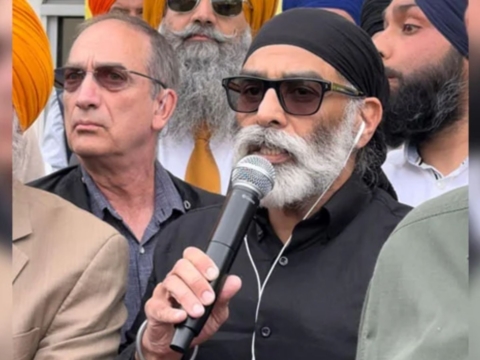When Mohandas Karamchand Gandhi decided to spin his own yarn and weave his own fabric, he wanted to inspire India to be self sufficient and to not be dependent or enticed by the western goods or lifestyle.
Inspired by Gandhiji, the Indian Prime Minister Narendra Modi’s “Make In India” campaign has come full circle. India is searching within its roots. For years, Indian fashion designers have seeked to break the rules and juxtapose Indian fashion alongside the trends in New York, Paris and Milan.
On the other hand, designers & high end labels from New York & Paris have looked to India for inspiration.
Drawing from the authentic, hand-crafted one of a kind techniques in a modern context to the adventurous, uniquely-spirited luxury clientele.
In Mumbai, where Bollywood and Indian fashion collide & collaborate, there is a new buzz.
Underneath one of Manish Malhotra’s showrooms, stretched across a large table are the latest saris fresh off the looms. The new collection “Regal Threads” is singing an old tune. Silks, Benarasis, woven using handlooms, just imperfect enough to be authentic in technique & texture.
“I am so happy the sari is back the way it used to be,” Malhotra says, of his decision to create these pieces using the handloom rather than power loom – a rewind to the original craftsmanship of the sari.
His team checks and irons the saris before delivering them to the shop floor.
For Malhotra is all about breaking the rules, and in the world of power looms and 3D printing, the slightly rustic, hand made in India has now made a comeback.
But, its not just technique, ‘Regal Threads’ is modern and fresh. Using traditional Benarasi brocade, overlaying bold, gold florals & paisleys on distinctively western plaids and stripes in neutral grays and blacks, Malhotra is able to blend the traditional and authentic with chic & modern.
Malhotra is among a wave of fashion designers enthused by the “Make In India” campaign. Launched in 2014, it aims to encourage business across the Globe to manufacture their goods in India.
In a recent interview with Diya TV, designer Anita Dongre says she has and continues to find inspiration in India. Her modern and traditional mix has garnered the attention of the diaspora worldwide and she plans to open a boutique in New York later this year.
Gaurav Bhatia, a luxury consultant and trend spotter, says, “[In the late 1990s], the sari fell out of favor in lieu of ‘Indo-Western’ wear, a trend that allowed a certain amount of casualness and perceived modernity, with kurtis (short, trendy tunics) and churidars (tight pants aka. The Indian legging).”
In 2011, LVMH’s Hermes launched a new line of saris for the Indian market. The Hollywood counterparts in India rocked the same designers from the west, until an option such as Hermes became available.
The Indian retail industry is a multi-billion dollar industry and the brands from the west now want a piece. Even brands such as Mango, Marks & Spencer and Zara began to arrive on the Indian high street – making Western clothing accessible and affordable. Make in India, however, has fostered a patriotism that has been critical in swaying Indian consumers back to the sari, says Bhatia.
“There’s now a great deal of pride in dressing Indian and wearing Indian. While the sari got lost for a while — with women in urban India choosing the convenience of Western wear — it’s now making a comeback.
“It’s about embracing one’s culture organically, and it’s cool to do so.”
The decision by Malhotra, and other designers, to return to the sari’s roots has been well received.
“I feel like a million bucks when I wear handloom saris,” says Gayatri Rangachari Shah, vice president for Tina Brown Live Media India.
“I know I am supporting weavers who need help in accessing new markets and customers. So many of our crafts are dying and it would make a big difference if everyone did their bit to support our centuries old talent.”
Shah is not alone: while spending on luxury goods in India grew 25 per cent in 2014, according to research firm Euromonitor, international brands still only account for a tiny share of the market.Indian consumers favor foreign brands when it comes to shoes, bags and watches, they prefer traditional dress when it comes to clothes.
In the south Indian city of Bengaluru, entrepreneurs Ally Matthan and Anju Maudgal Kadam last year started a viral campaign. The #100sareepact asks women to make a pledge to wear a sari twice a week — or 100 times a year — and share images of them doing so on social media.
With over 800 followers on Twitter, and with more than 7,500 posts under the hashtag on Instagram, the campaign has seen women post not just pictures of their saris, but has also sparked debate on drapes and weaves, and inspired women to share the stories behind their saris. If you want to get involved in the debate, you can do so by creating an Instagram, and you can always get free instagram followers without a survey if your profile is slow to get noticed; that way people are more likely to see your input.
Sangeeta Mhatre, who works for an international bank in Mumbai, is halfway into the year-long #100sareepact commitment, and says she has been pleasantly surprised by how her sari has been received in the office. “I find that saris command a lot more respect than any other form of office wear, and actually make a power statement the Indian way,” she says.
Malhotra, of course, is a man who understands the power of social media on fashion. The 50-year-old designer has over 700,000 Instagram followers and believes the platform is helping fuel the renaissance of traditional craftsmanship in the sari market. “I respect social media for that … there’s a lot of awareness celebrating art and crafts, and culture, and tradition,” he says.
“Various designers are doing interesting things with handloom and textiles and I think, for me at Manish Malhotra as a label, as a designer, as a person, its very exciting for me to do a lot of textile and most importantly is to get the sari back [in fashion].”
With the Spring Summer 2016 collection of Regal Threads, Malhotra is doing just that.
*This article was first published on CNN.




